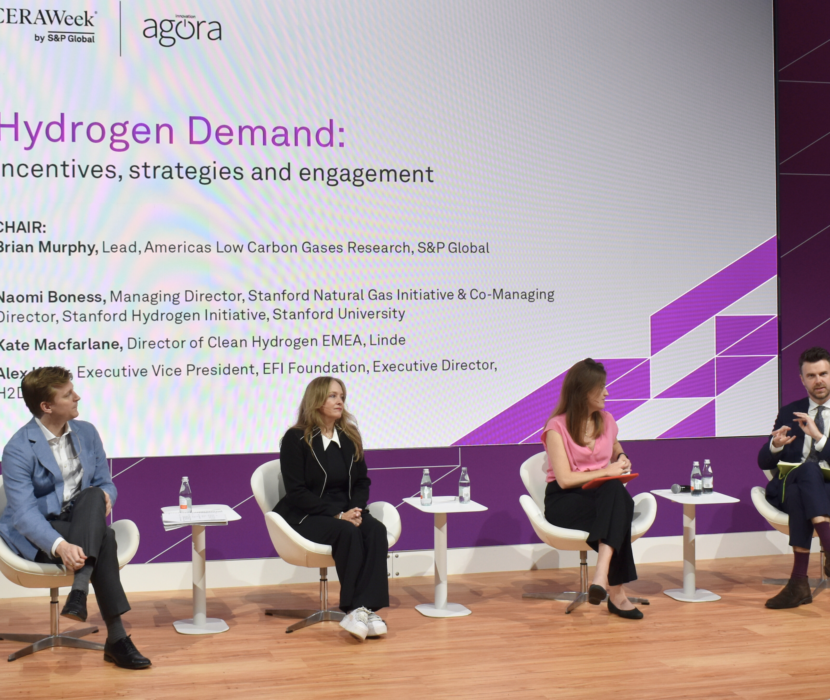
The 2023 Bipartisan Infrastructure Law provisioned funding to establish seven clean hydrogen hubs in areas ranging from the Pacific Northwest to the Gulf Coast, marking the most ambitious hydrogen development initiative thus far in U.S. history. Clean hydrogen has many potential applications across transit and industry, and could substantially decarbonize some of the most emissions-heavy sectors in the United States.
On May 29, 2024, the EFI Foundation (EFIF) released a new factbook with results from a recent survey of the perspectives of environmental justice groups on clean hydrogen development. The Clean Hydrogen and Environmental Justice Groups release webinar featured remarks from EFIF CEO Ernest J. Moniz and Director of Research Madeline Schomburg, followed by discussion among environmental justice experts on community engagement best practices and the varying attitudes that local environmental justice groups have about U.S. hydrogen development.
The ongoing research at EFIF focused on communities and featured at the webinar recognizes the importance of incorporating feedback from local organizers and environmental justice groups in the planning stage and ensuring that the needs of communities near these clean hydrogen hubs are respected during the development process.
In his opening remarks, Moniz emphasized the importance of community engagement in developing the U.S. hydrogen economy.
“This move toward generating the hydrogen economy has not generated completely monolithic responses. … We wanted to bring all voices into this conversation, and community engagement has been a central part of the hydrogen hubs program,” Moniz said.
More than 140 environmental justice groups have signed public letters citing a range of concerns about hydrogen development, such as hydrogen’s potential to perpetuate the fossil fuel industry, cause safety issues, and contribute to local air pollution. However, many environment justice groups surveyed within EFIF’s recent study (including those that signed letters) expressed support for “green” hydrogen, which is produced through electrolysis with renewable energy. Respondents noted green hydrogen’s potential to create jobs and help address climate change. Notably, in the survey, members of environmental justice groups often expressed views on hydrogen development that differed from the environmental justice organizations themselves.
Schomburg noted the often-complicated views that environmental justice advocates have on hydrogen development and discussed how unpacking these was a main goal of the survey report.
“[T]here was a high degree of support for hydrogen, which didn’t quite match the public rhetoric that we had seen. So we decided that we really needed to dig into this further to try to understand why that discrepancy existed,” she said.
Overall, 70% of environmental justice groups surveyed support hydrogen development as long as green hydrogen was being implemented. The survey also found that one of the key points of opposition centered on the environmental and climate impacts of using hydrogen that is produced from fossil fuels.
“The vast majority of both [environmental justice] groups opposed to hydrogen and groups who support green hydrogen are concerned that it could prolong our dependence on fossil fuels and it could create local air pollution issues,” Schomburg said.
Environmental justice groups have expressed particular concern that communities that have been previously harmed by industrial development and commodities extraction will be similarly marginalized during hydrogen development. During the event, Eleanor Smith, a community organizer with the Navajo Nation group Tó Nizhóní Ání, emphasized that this has been a particular concern among indigenous communities who have often borne harsh tolls from fossil fuel extraction.
“We have historically been a marginalized (to say the least) area for the fossil fuel industry. We’ve been a sacrifice zone for a whole century now for the fossil fuel industry—from coal, to oil, to gas, to uranium, to helium, and now to hydrogen development,” Smith said.
One of the greatest concerns of Tó Nizhóní Ání that Smith expressed relates to the water demands of clean hydrogen development—particularly in areas suffering from drought due to rising temperatures.
“We believe that all forms of hydrogen, including green hydrogen, are really not clean when you consider [areas] … experiencing mega drought,” Smith said. “We just don’t have the water to sustain green hydrogen development.”
The speakers recommended that organizations leading hydrogen development should engage directly with local communities, and stressed that hydrogen projects will not receive local support unless concerns about environmental fallout are remedied within the hydrogen development plans themselves.
Panelists emphasized that there is often a power imbalance between local communities and U.S. industry, and that planners should understand that this dynamic could inform how they incorporate feedback—or a lack thereof—from populations impacted by large-scale infrastructure projects.
“Something that project developers… working with communities often don’t see is the power imbalance that’s operating here. They seem to think they’re engaging with communities on an equal footing,” said Ruhan Nagra, founding director of the Environmental Justice Clinic at the University of Utah S.J. Quinney College of Law.
Stephanie Malin, co-director and co-founder of the Colorado State University Center for Environmental Justice, noted that communication between government and local communities is pivotal to building trust and support, and emphasized the need to ensure local organizations receive complete information about how hydrogen projects will be implemented.
“Context around who’s making decisions [and] how have these decisions been made … means a two-way street of communication,” Malin said. “But we also need access to information. Information that is useful, that is translated for non-specialists, and that is available in all relevant languages for any folks that are interested in participating in these processes.”
– Adam Patterson, Communications Associate
Ed. note: In January, EFIF was selected by the U.S. Department of Energy to lead the development of demand-side support mechanisms for the Regional Clean Hydrogen Hubs (H2Hubs). The Hydrogen Demand Initiative—H2DI — is designed to foster the long-term adoption of clean hydrogen and is focused on finding distinct sources for clean hydrogen in fields spanning shipping to materials production.
(Share this post with others.)




